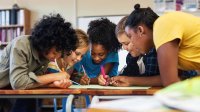A Powerful Lesson About Hurtful Words
This interactive lesson incorporates narrative storytelling and art to help students understand how damaging words can be.
Your content has been saved!
Go to My Saved Content.In middle childhood during the upper elementary years, children begin to expand their range of interactions and to understand others’ perspectives, feelings, and integrity. They start to learn about differences and to be accepting of them. This is also a time when children become sensitive to the impact of their words on others. As parents and teachers know, these kids certainly are sensitive to words used with them. Now, they begin to grasp the reciprocal effect.
Here is an activity that can be used in schools, extracurricular activities, and out-of-school groups to build the competencies noted above and more, as children exercise their social and emotional learning (SEL) skills in the service of building virtues like respect, fairness, and kindness.
A Hands-On Exercise in SEL
Start with a rationale: Think about a time when you joined something new, like a new class, group, or club. What feelings do you remember having? (Take a few replies.) Today, we are going to do an activity so that we can all understand what it means to join a group and how to make it easier for others when they join a new group.
Using chart or construction paper, draw and cut out a life-size silhouette/outline of a person (to avoid gender- or race-specific figures, you might want to cut the figure from green paper, prepared in advance; note also that children respond best when the silhouette is as close to life-size as possible, so consider creative options like taping several sheets of paper together).
Introduce the activity: Gather students in a group, and introduce them to their new “classmate.” (You might give the figure a name such as Greenie or Bluey to avoid any association with a real person.) Explain that new students often have difficulty fitting in because they are entering a situation where groups of students have already formed bonds of friendship. Point out that some people will automatically put up barriers to a new student, deciding quickly—without even trying to get to know him or her—that they dislike this new person.
Ask students to imagine that Greenie (for example) has just come into a classroom where students don’t pay much attention to newcomers and worry about people who are different. Tell them that you are going to read a short story about a day in school for Greenie.
Have them listen for every time a mean thing is said to Greenie. When they hear something mean, ask them to raise their hand. Then, either call on someone to come up and rip off (or cut off) a piece of Greenie’s body or do it yourself. Give the piece to a hand-raiser to hold on to. (Tip: When ripping or cutting, don’t remove small chunks; it will need to be obvious to students where each piece fits into the whole when they work to put Greenie back together at the end of the story.)
Here is the story: Greenie was pretty new in the school. As Greenie got on the bus and sat down toward the back, a student blocked Greenie’s way and said, “We don’t want you sitting with us.” When Greenie got to the classroom, Greenie put away Greenie’s coat and books and said hello to a few students, who said hello back.
In PE class, Greenie went to join a group of kids shooting baskets. One came over and said, “We don’t like people who are different from us.” Greenie went off and kicked a soccer ball with another group. When Greenie got to the next class and said hello to some new people, one said, “Your hair is a mess, Greenie.” During the class, Greenie was in a small group. Everyone took turns sharing their ideas about a book they were reading. After Greenie shared, a student in the group said, “Your ideas are not important at all.”
Ask students, If Greenie really was a new person in school and this happened, how might Greenie be feeling? Give at least half of the class a chance to express a feelings word. Then say, Since there were so many mean comments to Greenie, it’s time for everyone to help tape Greenie back together. Invite each student who has a piece of Greenie to come up and use tape to reattach his/her piece of Greenie in its proper place.
As each piece is reconnected, ask the students to say something apologetic to help Greenie feel better about what happened. You can prompt this by asking, “If someone had said some of these mean things to Greenie, what might they say to apologize and help Greenie feel less torn and more put-together?”
Getting to closure and summarizing key points: When the torn body is taped back together, no matter how hard the students have tried to fit the pieces back in, Greenie will not look the same as when students met her/him for the first time. Ask questions to lead students to the understanding that although some of the damage has been repaired, Greenie will never be exactly the same. Greenie’s feelings were hurt, and the damage remains.
Be sure to make this point: Apologies certainly help, but the chances are, this damage will never go away completely. Greenie will always remember what happened.
If possible, hang Greenie on a wall as a reminder of the power that words have to hurt and as a prompt to point to when incidents, or potential incidents, arise in the classroom. Greenie’s presence will serve as constant reinforcement of a vivid lesson in social and emotional and character development.
